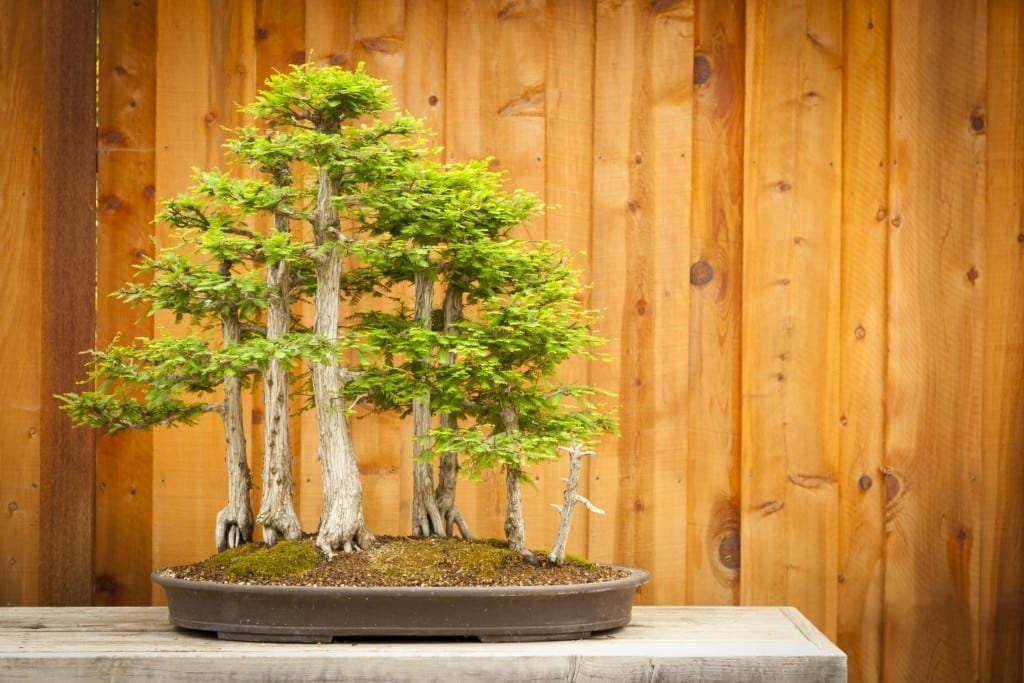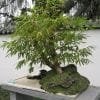In the wild, the Bald Cypress tree grows in wet, swampy soils along riverbanks and flood plains. Specimens of this plant have reached ages as old as 1000 years. Although the tree generally likes wetter climates, it has been grown as far north as Minnesota, New York and Southern Canada.
The circular strands the tree grows in are far different than how a Bald Cypress bonsai plant will grow. When looked at from afar, the strands of tree take on an almost dome-like shape. Needles on the tree grow in rows of two along the slender twigs. This deciduous plant loses its needles in winter, but may dried leaves will often remain on the Bald Cypress until springtime.
| Scientific/Botanical Name | Taxodium distichum |
| Description | The bald cypress is a deciduous tree that grows best in wet/soggy conditions. The needles may fall off the tree over the winter, or they may stay on the tree until the spring. The tree is a fast grower, and can achieve 36 inches of growth in just one year. |
| Position | The tree needs to be grown in full sun. It may be grown out of doors in USDA planting zones 5b to 9. |
| Watering | Plants grown in the south should be watered daily. Watering is best accomplished by submerging the pot in water for approximately 30 minutes. |
| Feeding | Feed with a fertilizer containing a 10-10-10 ratio of potassium, nitrogen and phosphorous twice a month during the growing season. |
| Leaf and Branch Pruning | Undesirable leaves may be removed throughout the growing season. Shaping is easily achieved by regular pinching-back of new shoots. The bald cypress bonsai looks best when trained into an upright and formal shape. |
| Re-potting & Growing Medium | Because the tree grows so rapidly, frequent re-potting is necessary. The plant must be grown in soil that is highly retentive of water. Mushroom compost is an excellent choice. |
| Wiring | The use of wires on Bald Cypress trees could cause damage to the bark because the tree grows quickly. Tying down the branches with twine is a better, more successful, alternative. |
| Notes | Bald cypresses that grow in the wild have lived to the grand age of 1000 years. |
Relatives
One of the closest relatives to the Bald Cypress is the Pond Cypress. Much like the Bald Cypress is appearance; the Pond Cypress has a smaller stature and grows around the edges of swamps. Seeds from this close relative are often eaten by neighboring squirrels and birds. As parts of the Taxodiaceae family, these two trees have much in common.
Growing A Bald Cypress Bonsai
Bald Cypress bonsai trees should be grown in full sun in zones 5B through 9. Although it can be grown outside of these ranges, the bonsai will need protection during the harsh months of winter. Growers should plan on watering the plant every day if the live in the south. During the summer, the pots of this plant should be submerged in water for 20 or 30 minutes for it to receive an adequate amount of water.
Many growers have had a great deal of success using a 10-10-10 ratio of Phosphorous, Nitrogen and Potassium. Place the fertilizer on it ever 2 weeks in late summer and autumn and weekly during early summer and spring. No fertilizer should be put on the bonsai during the winter.
Pruning & Wiring
When pruning the tree, try to keep in mind the styles that the Bald Cypress looks best in. Growers have noted some success growing it as a formal upright, group, twin-trunk, informal upright, literati and slanting. Normally, the plant will grow in the open in the wild and have a group of horizontal and drooping limbs. The formal upright is the best way to grow it into a bonsai tree, but others will work well also.
In Florida, many of the trees found will actually be an Everglades Cypress or a Pond Cypress. Since these trees are more scraggly, they grow better in the literati style. These more diminutive cypresses have branches that start almost at the ground and grow along the trunk.
The Bald Cypress is a very fast growing tree and has to be watched very closely. If growers do not keep an eye on their bonsai, the wires can potentially damage the bark. To prevent this, the branches could just be tied down using twine instead of wire. Some growers have noted success with making a slight incision on larger branches. This enables them to pull the branch down and the Bald Cypress will soon heal its wound.
Shaping The Foliage & Making Cypress Knees
To shape the foliage, just pinch back new growth. If the branch needs to be thickened, growers can let it grow on its own for a season and then prune it in the early spring. Wherever the tree is pruned, a new sprout will shoot out of the area. Leaves can be plucked off from desirably places and the tree can be pruned throughout the entire summer.
If the grower wants to develop cypress knees, they just need to go longer without repotting the plant. Normally, three years will suffice. Roots can be brought to the surface and allowed to thicken up to form the knee. Over the course of a few years, the bonsai’s root will thicken and look like the knees do in the wild.
Propagating & Repotting The Bald Cypress
Users can use cuttings or air layering to propagate their bonsai. Any potting or root pruning should be performed in spring. These plants have been known to grow three feet in just a single year, so root pruning needs to be done at a minimum of every other year.
Unlike other bonsai plants, the Bald Cypress does not need loose, gravely soil. In the wild, it is normally surrounded in swampy, wet earth and this effect should be recreated in real life. Heavy soils like mushroom compost work very well. If the soil is not heavy enough, the bonsai will not receive enough moisture. It is almost impossible to get the Bald Cypress’s roots to rot, so always select a soil that retains as much water as possible.
Pots for the Bald Cypress should be flat and shallow. To make it more aesthetically pleasing, the Bald Cypress normally matches earth tones and dull glazes very well. Since the pot will often be submerged in water, a smother finish can aid in cleaning off the dirt afterward.
Diseases & Pest Problems
Although the Bald Cypress is not susceptible to most pests, it does have a problem with Twig Blight. This weak pathogen is normally found on tissue that is dead or injured. If the tree is stressed from being over pruned, the fungus will attack and kill the tips of the branches. Any dead or diseased branches should be instantly pruned and not left on the tree. By pruning correctly and regularly fertilizing the soil, this issue can be avoided.
Overall, this plant does very well when grown as a bonsai. The elegant shape and feathery foliage look beautiful when paired with an earthen pot. Popular among bonsai aficionados of all types, this bonsai tree is especially well-suited for beginners. It is simple to grow and not susceptible to a broad ranges of diseases and pests. For anyone looking to pick up bonsai as a hobby, the Bald Cypress is a great first choice. The iconic shape is well-suited to bonsai trees and easy to make for any new hobbyist.


